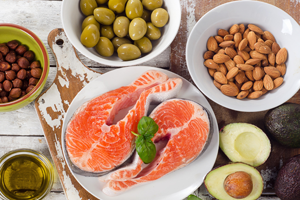
Mono fats, Poly fat, Saturated fats, Trans fats…………Aargh!!!! It’s enough to make your head spin! Good fats, Bad fats. What do they do and how the heck can you make sense of it?
Yes there are good fats and bad fats. I’m writing this because for many years I was very confused as to what fats were the right fats. But it really is pretty simple. Just 2 types – Saturated and Trans fats are the ones to stay away from. The others are Monounsaturated and Polyunsaturated Fats. Saturated = Bad, Unsaturated = Good. Okay but once you become a label reader you soon find out that it is really next to impossible to not consume saturated fats. So is there a safe(?) amount that we can consume? Yes.
The Dietary Guidelines for Americans recommends consuming less than 10% of your daily caloric intake. And the American Heart Association actually recommends no more than 7% of your daily intake. And by all means stay away from Trans Fats.
So if you want to stick with the healthy fats you’re going to be looking for the UN next to saturated. As in Monounsaturated and Polyunsaturated. Where can you find these?
Monounsaturated Fats can be found in:
- Olive, Peanut and Canola Oils
- Avocados
- Almonds, hazelnuts and pecans
- Seeds such as pumpkin and sesame seeds
Monounsaturated Fats have been proven to improve blood cholesterol and control insulin levels and blood sugar.
Polyunsaturated Fats can be found in:
- Sunflower, corn, soybean and flaxseed oils
- Walnuts
- Flaxseeds
- Fish – also known as Omega-3 fats. You can find these in fish.
- Canola Oil
And like Mono, Polyunsaturated Fats improve blood cholesterol and can decrease the risk of type 2 diabetes.
The American Heart Association states that there is evidence that eating up to 15% of daily calories from Polyunsaturated Fats in place of Saturated Fat can lower heart disease risk.
Okay so we now know what to look for to get the good fats. What foods should we stay away from that hold a lot of the bad fats? – Saturated and Trans.
Sources of saturated fat include red meat, poultry and full-fat dairy products. Saturated fats raise blood cholesterol levels which can increase your risk of cardiovascular disease. And saturated fats may increase your risk of type 2 diabetes.
Trans fats occur when hydrogen is added to the cooking process. AKA hydrogenation. Also think deep frying. BAD
Hopefully this will clear up any confusion. Before I wrap this up though I want you to note something. Above I told you that poultry was high in saturated fat. Yet we’re always telling people to eat chicken due to its protein source. Check this chart out. As you can see the breast of the chicken actually has by far the least amount of cholesterol compared to the rest of the bird. That along with its high content of protein makes it an excellent food choice, whether it be for a meal or a snack.
Get our Latest Updates and Events right in your Inbox. Sign up below.